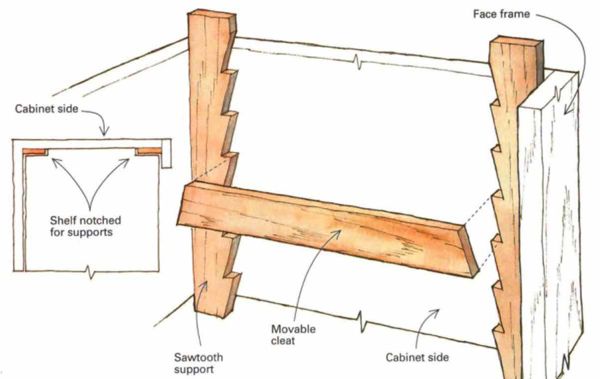
Synopsis: Stephen Winchester tries to balance style, function, and cost when figuring out how to support shelves in a cabinet. The five methods he uses most often,are blind-nailed dadoes, shelf standards, shelf pins, invisible wires, and sawtooth supports. Multiple drawings and photos illustrate each method, and Winchester tells you which method works best for which use.
I earn my living by making cabinetry—not cookie-cutter kitchens, but one-of-a-kind pieces and custom built-ins. Every cabinet I build has at least one shelf. And some—hutches and book cabinets, for example have many. As both designer and fabricator in most cases, I try to balance style, function and cost when figuring out how to support shelves in a cabinet.
Over the years, I have come to favor several techniques that achieve that happy balance between elegance and efficiency. My methods aren’t as crude as using stamped-steel brackets but neither are they as fussy as routing tapered sliding dovetails.
Fixed or adjustable shelving
Style of cabinetry is the most important factor in determining which of the methods of shelving support I use. The next most important factor is cost. For cabinets in kitchens, pantries and utility rooms, fixed shelves are generally fine. But for most of my work, clients want adjustable shelves. Shelf standards, long vertical tracks that go into a case’s sides, are the most visible and utilitarian-looking, but they’re also the quickest to install. Drilling holes in the side of the case for shelf pins is the next quickest. Another technique employs what I call invisible wires that slip into thin kerfs in the ends of the shelves. And there are sawtooth supports, which are quite elegant, but relatively time-consuming. The more complicated the method, the more I have to charge.
As far as function goes, any of these supports will hold a reasonable load: 3 ft. of books shouldn’t be a problem. Even the thin, invisible wires have a tremendous amount of shear strength. In the rare instances I’ve made shelves longer than 36 in., I’ve used a strongback, which is a wooden reinforcing bar either beneath or at the front of a shelf. Even with a strongback, though, I wouldn’t plan to stack 4 ft. of encyclopedias on an otherwise unsupported shelf.
From Fine Woodworking #120
For the full article, download the PDF below:
Fine Woodworking Recommended Products

Jorgensen 6 inch Bar Clamp Set, 4 Pack

Blum Drawer Front Adjuster Marking Template

Stanley Powerlock 16-ft. tape measure






















Log in or create an account to post a comment.
Sign up Log in